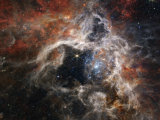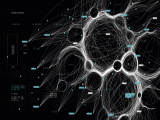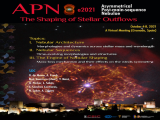Headlines and events archive
Displaying 101 - 150 of 1543
You may also find an archive of news published in the media which are related with the Instituto de Astrofísica de Andalucía - CSIC.
Pages

|
16/01/2024 - 12:30
UGR bureocrazy for dummies: PhDs fight back Every year we all wonder about the UGR bureaucracy: did we miss something? how could we have known in advance? Let's face it, it's a mess. To try to help us all, especially those who are just starting, I would like to invite everyone interested to a seminar dedicated to understanding what the PhDs have to go through every year (paperwork related), where to find the proper information, who to contact in case of doubt and how to go through the PhD... Teresa Toscano |

|
27/11/2023 - 01/12/2023
https://www.granadacongresos.com/starform2023 Granada |

|
16/11/2023 - 17/11/2023
https://indico.iaa.csic.es/event/4/ Granada |

|
31/10/2023 - 12:30
Outflows from low to high luminous AGNs Outflows are believed to play a major role in the evolution of galaxies and are said to be ubiquitous within the active galactic nuclei (AGN) population. However, we still lack a comprehensive view of their properties and impact in their host galaxies and the surrounding medium. If we focus on the low luminosity part of the AGN family, in particular in low ionisation nuclear emission-line regions (LINERs), the impact of outflows is still largely... Laura Hermosa Muñoz |

|
03/10/2023 - 12:30
Young massive clusters in the Gaia era After the detection of gravitational waves and the realisation of the wide diversity among core-collapse supernova explosions, Interest in massive stars has been rekindled. Young open clusters are our natural laboratories to explore the lives and deaths of massive stars, and most of our current understanding comes from their study. Until recently, we have been strongly limited by practical difficulties and small number statistics. Most open... Dr. Ignacio Negueruela |

|
26/09/2023 - 12:30
Coloquio SO: Extracting stellar populations and (mainly) emission line information out of S-PLUS photometry We present tests of a new method to simultaneously estimate stellar population and emission line (EL) properties of galaxies out of S-PLUS photometry. The technique uses the AlStar code, updated with an empirical prior which greatly improves its ability to estimate ELs using only the survey's 12 bands. The tests compare the output of (noise-perturbed) synthetic photometry of SDSS galaxies to properties derived from previous (STARLIGHT-based)... Dr. Roberto Cid Fernandes |

|
30/11/2023 - 12:30
SO Colloquium: Studying star-formation in 'collisional' galaxies with MUSE Galaxies in pre- and post-collisional stages are an excellent laboratory to study the evolution of galaxies, particularly the triggering and suppression of star formation on galactic scales before and after such interactions. In order to analyze the star formation triggered in these systems, we started a series of studies on 'collisional' galaxies with available integral field spectroscopy (IFS) observations. We use Very Large Telescope (VLT)... Dr. Victor Mauricio A. Gómez González |

|
21/09/2023 - 12:30
SO Colloquium: Testing black hole structure with very-long-baseline interferometry Black holes hold a tremendous discovery potential, and experiments such as the Event Horizon Telescope and its next generation upgrade could provide important cues about their structure. New physics beyond general relativity can modify the structure of black holes and leave imprints on image features, for instance changing the separation between photon rings or generating additional sets of photon rings. Both cases motivate the study of the... Dr. Raul Carballo |

|
14/09/2023 - 12:30
X-ray emission from Symbiotic Stars: a stellar window to the Astrophysics of AGN Symbiotic stars (SySts) are binary systems in which a white dwarf (WD) accretes material from a red giant star. X-ray studies of SySts reveal an apparent variety of processes which would suggest different origins. In this talk I will briefly review our current knowledge of the X-ray properties of SySts (their classification and physical parameters), in particular I will describe the iconic systems R Aqr and CH Cyg. Finally I will present our... Dr. Jesús Toalá |

|
09/10/2023 - 12:30
SO Colloquium: The demographics of small exoplanets The diversity of the exoplanet population is beyond our imagination. The more than 5000 known exoplanets vastly differ in mass, size, orbital period, dynamics, and host type. Demographic studies, however, aim to find patterns in the population that inform us about their origin, composition, and evolution. Among these features, perhaps the most surprising is the abundance of planets with no analog in the solar system, also known as sub-Neptunes.... Dr. Rafael Luque |

|
16/11/2023 - 12:30
SO Colloquium: The evolution of the accretion process: investigating the protostellar phase to constraints planet formation The accretion process is responsible for the mass building during the star formation phase, but our knowledge of this phenomenon is still not totally understood. On one side, the magnetospheric accretion scenario describes the accretion on pre-main sequence (Class II/III) low-mass stars. However, most of the material is supposed to be accreted during the earliest stages, i.e. the protostellar phase (Class 0/I), when the forming star and its disk... Dr. Fiorellino, Eleonora |

|
09/10/2023 - 11/10/2023
https://www.iaa.csic.es/meetings/sophi-team-meeting Granada |

|
11/07/2023 - 13/07/2023
https://www.granadacongresos.com/refsh?fbclid=IwAR0bl7jxUevZ_ohUT6wdE3CrxZ3gQATl… Granada |

|
24/10/2023 - 13:00
The Galactic Center seen with MeerKAT During its inauguration, the MeerKAT released, to date, the most detailed image of the centre of the Galaxy at L-band (1.28 GHz). Since then, the data have been exploited for various scientific research. One such exploitation was to produce a high resolution mosaic of the Galactic centre. From this mosaic came a catalogue of newly discovered unresolved point sources. Over 1500 sources were identified, of which 20 are steep spectrum point... Dr. Isabella Rammala |

|
07/11/2024 - 12:30
SO Colloquium: The tidal arms of open star clusters are much longer than thought, but more difficult to find The tidal arms of stellar clusters are an important tool for studying the clusters’ birth conditions, their evolution, coupling, and interaction with the Galactic potential. They also help understand how field stars populate the Milky Way. Thanks to Gaia, much progress has been accomplished in finding the tidal arms of open clusters. I will show here that such arms are much longer than previously observed, and that their identification requires... Dr. Henri Boffin |

|
06/07/2023 - 13:00
La acreditación Severo Ochoa-IAA 2023-2027 To be provided Dr. Isabel Márquez |

|
19/10/2023 - 17:00
SO Webloquium: Feeding and Feedback: How to Make a Starburst and What that Means for the Host Galaxy The cycle of star formation governs the evolution of galaxies. In some local galaxies, the star formation rate in their centers are much higher than other normally star-forming galaxies and may be more similar to galaxies at earlier cosmic times. I present observational results from two archetypal nearby starburst galaxies: NGC253 and M82. First, I will discuss how gas flows to the center of NGC253 along its bar to fuel the extreme burst of... Dr. Rebecca C. Levy |

|
23/11/2023 - 12:30
SO Colloquium: The transition between super-Earths and sub-Neptunes: Interior and atmosphere modelling of the low-mass planet population Low-mass exoplanets are showing a diversity in their densities, ranging from silicate-dominated super-Earths to volatile-rich sub-Neptunes. We have developed a coupled interior-atmosphere model that estimates the composition and interior structure of super-Earths and sub-Neptunes assuming water and CO2 atmospheres. The applications of the model include the homogenous analysis of a sample of multi-planetary systems, as well as the assessment of... Dr. Lorena Acuña |

|
26/10/2023 - 12:30
SO Colloquium: Multi-fluid solar chromosphere The solar chromosphere is the boundary layer between the interior and exterior of the Sun, routing the origins of the coronal heating. New large-aperture solar telescopes, such as the future 4-meter European Solar Telescope or American DKIST, have among their primary focus observations of chromospheric magnetic fields. The correct interpretation of solar data requires sophisticated theories. The solar chromosphere is made of strongly stratified... Dr. Elena Khomenko |

|
28/06/2023 - 12:30
Un universo de diversidad: historias LGTBI en el mundo de la razón y la ciencia El neurólogo Ben Barres, que murió hace unos pocos años, escribió un texto en Nature muy interesante sobre ciencia y género y en él decía: "The progress of science increasingly depends on the global community, but only 10% of the world’s population is male and caucasian. To paraphrase Martin Luther King, a first-class scientific enterprise cannot be built upon a foundation of second-class citizens." Él era transexual. El mundo de la ciencia,... Dr. Javier Armentia |

|
28/09/2023 - 12:30
A VLTI view of Massive Young Stellar Objects (MYSOs) The formation of massive stars, objects with masses larger than 8 times solar, is central to both stellar astronomy and galactic evolution. In recent years, significant progress has been made in understanding the formation of high-mass young stellar objects (MYSOs; i.e. M∗ ≥ 8 M⊙, Lbol ≥ 5 x 103 L⊙. The latest observational and theoretical studies present evidence that HMYSOs are born in the same way as their low-mass counterparts, via disc... Dr. Maria Koutoulaki |

|
05/03/2024 - 12:30
SO colloquium: A new digitized age of SETI – interferometric commensal observations and machine learning The search for technosignatures - remotely observable indicators of advanced extraterrestrial life - addresses one of the most profound questions in science: are we alone in the universe as intelligent life? The Breakthrough Listen program is leading the most concerted search for extraterrestrial intelligence (SETI) effort to-date through radio and optical surveys of nearby stars, nearby galaxies and the Milky Way galactic plane, thus... Dr. Cherry Ng |

|
20/07/2023 - 12:30
Near-Infrared Observations of Clustered Massive Star Formation in Outflowing Region AFGL 5180 Massive stars are significant throughout the universe, as they impact their surroundings from the early stages of their formation until they die in the form of supernova. Observations in the near-infrared (NIR) of the bright and large-scale (~pc) jets which young stars ubiquitously produce during their formation process can place important constraints on the phenomenon of massive star formation. Here, we present a detailed NIR view of the star-... Sam Crowe |

|
06/06/2023 - 12:30
Aperture Masking Interferometry with the JWST In this talk, I will present how the aperture masking interferometric (AMI) mode of the JWST works. I will describe the main characteristics of this mode. In particular, I will show some of the advantages of the mode complementary to standard imaging and coronagraphic observations. I will also introduce the basic principles of the AMI data analysis, including the extraction of the interferometric observables and their interpretation with... Dr. Joel Sanchez Bermudez |

|
13/07/2023 - 11:00
Solar Orbiter: An example of an international collaboration Solar Orbiter is a space mission of international collaboration between ESA (European Space Agency) and NASA. Solar Orbiter was launched on February 9th 2020 from Cape Canaveral, FL onboard of an Atlas V 411 rocket. This event signified the success of the diplomatic, economical, technological, and scientific effort of many countries and two space agencies to achieve a common goal. The outcomes from this mission will aid to the scientific... Dr. Teresa Nieves Chinchilla |

|
24/05/2023 - 26/05/2023
https://sites.google.com/view/qftcsworkshop2023/home Granada |

|
15/05/2023 - 19/05/2023
https://www.granadacongresos.com/els2023 Almuñecar |

|
09/11/2023 - 12:00
Studying magnetic fields, dynamics, and fundamental physics near a black hole with current and future mm-VLBI instruments The Event Horizon Telescope (EHT) has imaged the black hole shadows of the supermassive black hole at the center of the galaxy M87 (M87*) and at the center of the Milky Way (Sgr A*). Polarimetric imaging of M87* with the EHT enabled significantly stronger inferences on the black hole and accretion parameters than total intensity data alone. Geometric modeling was a central tool for studying the structure of M87* and Sgr A* in total intensity. In... Dr. Freek Roelofs |

|
21/06/2023 - 21/06/2023
https://docs.google.com/forms/d/e/1FAIpQLSf3LCWdpRFmz0JVl9GtG52KDRaGLKNEEw674XWk… Granada |

|
02/04/2024 - 12:30
Single-photon gig in Betelgeuse’s occultation In the realm of astronomical exploration, cutting-edge technologies are indispensable. Single-Photon Avalanche Diode (SPAD) sensors offer unparalleled precision, enabling the detection of individual photons with remarkable timing resolution. However, the current use of single-pixel SPAD devices poses limitations on spatially-resolved imaging in astronomy. Enter two-dimensional SPAD detectors, revolutionizing observation capabilities and enabling... Dr. Francisco Prada |

|
16/05/2023 - 12:00
Seminario Centro de Cálculo Nueva infraestructura de cálculo del IAA Centro de Cálculo |

|
24/04/2023 - 28/04/2023
https://www.granadacongresos.com/ctac-ctao Granada |

|
24/04/2023 - 28/04/2023
https://www.granadacongresos.com/gcw2023 Granada |

|
25/04/2023 - 12:30
SO colloquio: Theoretical models for the formation and evolution of Ultra-Cool Dwarf planetary systems Rocky planets located in the habitable zones around very low-mass objects are ideal targets for searching for life outside our Solar System. In order to better understand their formation and evolution, N-body simulations are needed. These simulations are developed assuming a star close to the substellar mass limit as the central object. The simulations include tidal and general relativistic effects that incorporate the contraction and evolution... Dr. Mariana Sánchez |

|
11/05/2023 - 12:30
Off-centre supermassive black holes in bright central galaxies Supermassive black holes (SMBHs) are believed to reside at the centre of massive galaxies such as brightest cluster galaxies (BCGs), the most massive galaxies which can be found in today's Universe. However, as BCGs experienced numerous galaxy mergers throughout their history, the central BH can be significantly kicked from the central region by these dynamical encounters. By combining the Illustris-TNG300 simulations and orbital integration... Dr. Aline Chu |

|
05/10/2023 - 12:30
SO colloquium: A Light in the Dark - Massive Star Birth Through Cosmic Time Massive stars are important throughout the universe, but their formation remains poorly understood. I review current understanding of how massive stars form in our Galaxy, in particular examining observational tests of various predictions of Core Accretion and Competitive Accretion theories. Finally, I discuss how massive star formation may have been different in the very early universe and how the first stars may have become supermassive... Dr. Jonathan C. Tan |

|
01/06/2023 - 12:30
SO webloquio: The impact of stellar composition: from galactic chemical evolution to planet formation The characterization of solar-type stars is fundamental for various fields in astrophysics, including exoplanet detection and the chemical evolution of our Galaxy. In particular, the determination of chemical abundances for stars at different metallicities and ages provides us with a key insight on how and when the various chemical elements were formed within the Galaxy. The chemical trends observed in different parts of the Galaxy (thin disk,... Dr. Elisa Delgado Mena |

|
04/05/2023 - 12:30
SO colloquio: Pulsar astrophysics in the era of large surveys History tells us that with new telescopes and new data processing techniques come new discoveries and breakthroughs in pulsar astrophysics. Despite nearly 55 years since their discovery, fundamental open questions remain in almost all areas of research. Examples include the birth properties and environments, the magnetic field configuration and evolution, the interactions of the superfluid interior with the solid crust, the processes of... Dr. Aris Karastergiou |

|
28/03/2023 - 12:30
International Asteroid Impact Defense Collaboration The defense of our planet against asteroid impacts counts on international collaboration. NASA's OSIRIS-REx and Japan's Hyabusa2 spacecraft studied two potentially hazardous asteroids Bennu & Ryugu and bring samples back to Earth. NASA's DART, Italy's LICIACube and ESA's Hera spacecraft test a method of planetary defense against asteroids. Dr. Humberto Campins |

|
16/03/2023
The visit to the IAA-CSIC of its External Scientific Advisory Board (ESAB) is over On March 14 and 16, the External Scientific Advisory Board (ESAB), composed of internationally recognized researchers, visited the IAA-CSIC facilities to review the activities of the IAA and to provide advice on future actions. |

|
08/05/2023 - 10/05/2023
https://www.granadacongresos.com/skaopenscience Granada |

|
20/06/2023 - 12:30
Radio continuum halos in nearby galaxies and the CHANG-ES project About a decade ago, the upgrade from the classic Very Large Array into the EVLA, i.e. the Karl G. Jansky Very Large Array (VLA), made it possible to observe fainter radio continuum emission than ever before. The project Continuum Halos in Nearby Galaxies - an EVLA Survey (CHANG-ES, PI: J. Irwin) has allowed us to probe gaseous halos of 35 edge-on galaxies with arcsecond details and faint microJansky/beam sensitivities, and to begin answering... Theresa Wiegert |

|
22/06/2023 - 12:30
SO colloquium: X-ray Polarimetry: a New Window to the Universe Polarimetry is a very important technique for understanding magnetic fields and high-energy processes in the Universe. While we have been studying polarization in the radio and optical side of the electromagnetic spectrum for decades, what happens at higher energies has, until recently, eluded us. In 2021 NASA finally launched the first X-ray polarimeter, the Imaging X-ray Polarimetry Explorer - IXPE, offering us a completely new window to the... Dr. Yannis Liodakis |

|
27/04/2023 - 12:00
El Futuro de la Astrofísica de muy altas energías a través del Open Science: Oportunidades con el Cherenkov Telescope Array Observatory (CTAO) El jueves 27 de abril a las 12:00 CEST, el Cherenkov Telescope Array Observatory (CTAO) y el Instituto de Astrofísica de Andalucía (IAA-CSIC) celebrarán un evento gratuito y abierto para investigadores interesados en la Ciencia Abierta y posibles sinergias con el CTAO, así como para estudiantes de grado, máster y doctorado que deseen desarrollarse profesionalmente en el campo de la Astrofísica de muy altas energías. El seminario, que tendrá... Dr. Roberta Zanin, Dr. Juan Cortina, Dr. Rubén López Coto y Dr. Francisco Colomer |

|
02/03/2023 - 12:30
J-PAS: a survey for tracing the role that star formation and environment play in galaxy evolution The processes that explain the evolution of galaxies from the blue cloud to the red sequence are still under discussion. Internal processes, named as mass-quenching, because they are linked to the galaxy mass or AGN feedback, could be responsible of the rapid quench of the star formation in galaxies. Besides the stellar mass, the evolution of the galaxy populations is also a function of the environment. Unlike the mass quenching, the... Dr. Rosa González Delgado |

|
04/10/2021 - 08/10/2021
http://apn8.iaa.csic.es Granada |

|
13/04/2023 - 12:30
Coloquio SO: A holistic approach to exoplanet spectroscopy During the last two decades, multiple observation techniques have enabled the study of exoplanet atmospheres, informing us about their chemical composition, thermal distribution and transport processes. The most successful techniques include low-resolution transit and eclipse spectroscopy, phase curves, and high-resolution Doppler spectroscopy. In all cases, the extraction of the atmospheric signal presents a challenge, being comparable to or... Guiseppe Morello |

|
07/03/2023 - 12:30
Sub-milliarcsecond astronomy with Imaging Atmospheric Cherenkov Telescopes The angular size of a star is a critical factor in determining its basic properties. Together with the distance, it provides the physical diameter of the star which can be used to yield luminosity and mass estimates. Direct measurement of stellar angular diameters is difficult: at interstellar distances stars are generally too small to resolve by any individual imaging telescope. This fundamental limitation can be overcome by several methods... Dr. Tarek Hassan |

|
21/04/2023 - 12:30
Gamma rays as cosmic ray tracers: how can CTAO contribute to the cosmic ray physics Gamma-ray emission produced by interactions of cosmic rays with interstellar matter and radiation fields is a probe of non-thermal particles in galaxies. After decades of instrumental improvements in the field of gamma-ray astronomy, different scales and environments are now accessible and their gamma-ray observations reveal several properties of cosmic rays, especially in our Galaxy. I will provide a short review of the status of the subject... Roberta Zanin |

|
23/03/2023 - 12:30
SO coloquio: Investigating the impact of quasar feedback on the central kiloparsecs of galaxies Active galactic nuclei (AGN) feedback is the effect that nuclear activity produces in the interstellar and circumgalactic medium of galaxies. Different modes of AGN feedback, which can be broadly divided into radiative/quasar and kinetic/radio, are now considered key processes in the evolution of massive galaxies by regulating black hole and galaxy growth. Indeed, a wealth of observational evidence demonstrates that feedback from supermassive... Dr. Cristina Ramos Almeida |